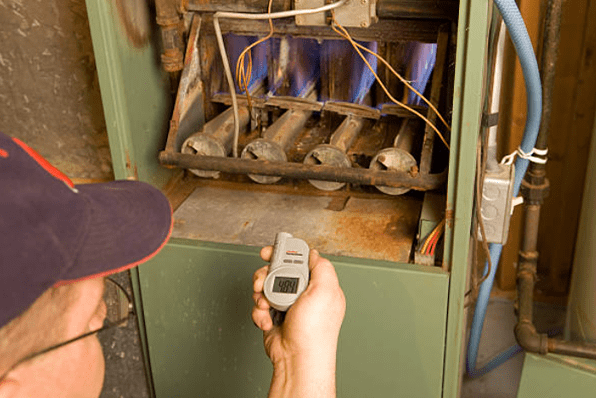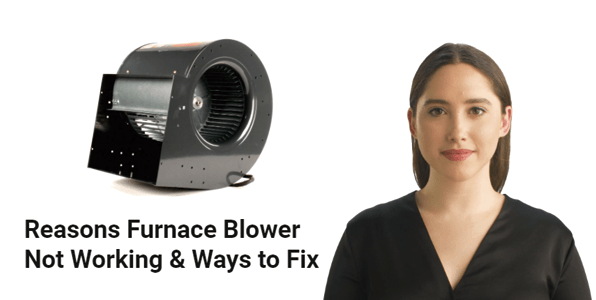Video: 10 Reasons Furnace Blower Not Working & Ways to Fix

Figure 1: Fan oven.
When the furnace blower fails to function, it can lead to chilly
discomfort in your home during the colder months. The furnace blower is a crucial component responsible for
circulating warm air throughout your living space. Understanding the common causes behind a non-working blower and
knowing how to address these issues can save you from the inconvenience of a malfunctioning heating system.
In this article, we will explore the most common causes of a furnace blower not working and provide practical
solutions to get it up and running. First let’s learn the signs of a faulty furnace blower.
1. Identifying Symptoms of a Faulty Furnace Blower
The furnace blower serves as the powerhouse of your heating system, responsible for distributing heated air from the
furnace into your living spaces. Without it, the warmth generated by your furnace remains trapped, rendering the
heating ineffective.
Recognizing signs of a malfunctioning blower is crucial for early intervention. Common indicators include:
1. No Air Circulation
Lack of air movement through vents despite the furnace running.
2. Inconsistent Heating
Uneven heating or certain rooms remaining colder than others.
3. Strange Noises
Unusual sounds like rattling, banging, or whirring coming from the furnace.
4. Increased Energy Bills
A sudden spike in energy consumption without a proportional increase in heating.

Figure 2: Gas furnace working diagram from hvacrschool.com.
2. 10 Common Causes of Furnace Blower Not Working
2.1 Wiring Problem
Wiring issues are a common culprit when it comes to a malfunctioning furnace blower. Loose connections, damaged wires, or faulty electrical components can disrupt the flow of power to the blower motor, preventing it from operating.
2.2 Capacitor Failure
The capacitor is responsible for providing the necessary jolt of electricity to start the blower motor. If the capacitor fails, the motor may not receive the required electricity, leading to a non-functioning blower.
2.3 Blower Motor Problem
The blower motor itself can be a source of trouble. Over time, motors can wear out, suffer from electrical issues, or simply fail to operate. A malfunctioning blower motor will result in a lack of airflow, leaving your home without proper heating.

Figure 3: Oven racks.
2.4 Blower Motor Bearing Damage
If you hear unusual sounds like squeaking or grinding coming from the blower motor, it could indicate bearing damage. Worn-out bearings can hinder the motor's rotation, causing the blower to stop working.
2.5 Thermostat Not Set Correctly
Sometimes the issue is not with the furnace itself but with the thermostat. Ensure that the thermostat is set to the desired temperature and mode. Incorrect thermostat settings can prevent the blower from activating.
2.6 Loose Thermostat Wiring
Loose thermostat wiring can also lead to the blower not working. Check for loose or damaged wires and address any issues with the thermostat wiring to ensure proper communication with the furnace.
2.7 Control Board Failure
The control board acts as the brain of the furnace, orchestrating various functions, including the blower's operation. If the control board fails, it can disrupt the entire heating system, resulting in a non-working blower.

Figure 4: Furnace control board.
2.8 Air Filter Clogged
A clogged air filter is one of the most common causes of furnace issues. When the filter is clogged with dust and debris, it restricts airflow, putting extra strain on the blower motor and eventually causing it to stop working.
2.9 Lack of Maintenance
Regular maintenance is crucial for the optimal performance of your furnace. Neglecting routine tasks such as cleaning, lubricating moving parts, and inspecting electrical components can lead to various issues, including a non-functioning blower.
2.10 Worn or Cracked Furnace Blower Belt (If There is One)
Some furnaces have a blower drive belt that connects the motor to the blower wheel. If this belt is worn or cracked, it can slip or break, causing the blower to stop working. Regular inspection and replacement of the drive belt are essential for proper functionality.

Figure 5: Furnace blower belt from cielowigle.com.
3. Furnace Blower Not Working? How to Fix
1. Wiring Problem
Solution: Inspect the furnace wiring for loose connections or damage. Tighten any loose connections and replace
damaged wires. If you're not comfortable with electrical work, it's advisable to seek professional assistance.
2. Capacitor Failure
Solution: Test the capacitor using a multimeter. If it's faulty, replace it with a new one. Capacitor replacement is
a straightforward task, but if you're unsure, consult a professional.
3. Blower Motor Problem
Solution: If the blower motor is the issue, it may need to be repaired or replaced. Consult a qualified HVAC
technician to diagnose the motor's condition and take appropriate action.
4. Blower Motor Bearing Damage
Solution: If you suspect bearing damage, it's best to replace the bearings or the entire blower motor. Ignoring this
issue can lead to further damage and a complete motor failure.
5. Thermostat Not Set Correctly
Solution: Check the thermostat settings and ensure they are correctly configured. Replace batteries if necessary and
consider upgrading to a programmable thermostat for added convenience.

Figure 6:Furnace thermostat.
6. Thermostat Wiring Problem
Solution: Inspect thermostat wiring for any signs of wear or damage. Replace damaged wires and ensure a secure
connection. If in doubt, consult a professional technician.
7. Control Board Failure
Solution: A malfunctioning control board requires professional attention. An HVAC technician can diagnose the issue,
replace the control board if necessary, and ensure the proper functioning of the furnace.
8. Air Filter Clogged
Solution: Replace the air filter regularly, ideally every 1-3 months, depending on usage. A clean filter ensures
unrestricted airflow, reducing strain on the blower motor.
9. Lack of Maintenance
Solution: Schedule regular furnace maintenance, including cleaning, lubricating moving parts, and inspecting
electrical components. Professional HVAC technicians can perform comprehensive maintenance to prevent future issues.
10. Worn or Cracked Furnace Blower Drive Belt
Solution: Inspect the drive belt for signs of wear or damage. Replace it if necessary, following the manufacturer's
guidelines. Regularly check and replace the drive belt as part of routine maintenance.

Figure 7:Furnace blower replacement.
4. DIY Solutions for Furnace Blower Issues
Certain issues can be resolved without professional assistance:
1. Replacing Air Filters:
Regularly replacing or cleaning air filters ensures proper airflow and reduces strain on the blower.
2. Cleaning the Blower Assembly:
Carefully clean the blower assembly, fan blades, and motor to remove accumulated dust and debris.
3. Checking and Adjusting Belts:
Inspect fan belts for wear and tear, adjusting or replacing them as needed for smooth operation.
5. When to Seek Professional Help
Some furnace blower issues require expert attention:
1. Electrical Repairs:
Any electrical repairs or wiring issues should be handled by certified technicians to prevent hazards.
2. Motor or Mechanical Problems:
If the blower motor or other mechanical components are damaged, professional repair or replacement is necessary.
3. Complex Thermostat Problems:
Troubleshooting complex thermostat issues should be left to HVAC professionals to ensure correct diagnosis and
repair.

Figure 8:Check gas furnace output temperature.
6. Conclusion
A malfunctioning furnace blower can significantly disrupt your home's comfort during colder months. Recognizing the symptoms, conducting basic troubleshooting, and knowing when to seek professional help are essential in maintaining a functional heating system. Regular maintenance and timely interventions can extend the life of your furnace blower and ensure consistent warmth in your home.



